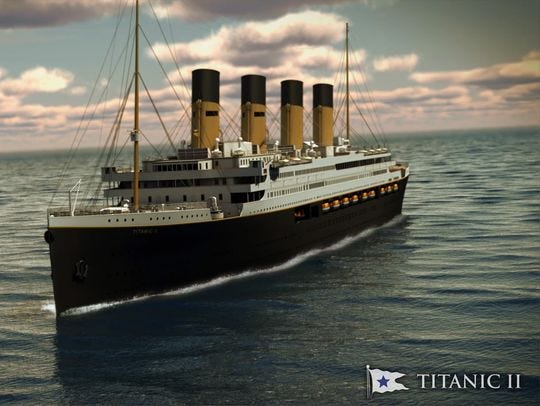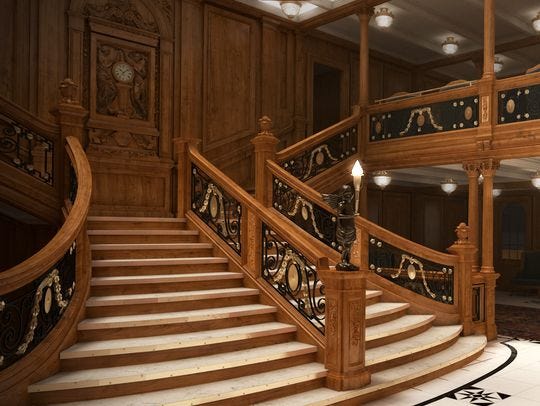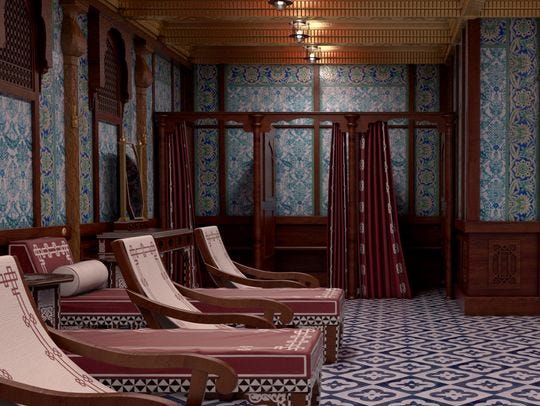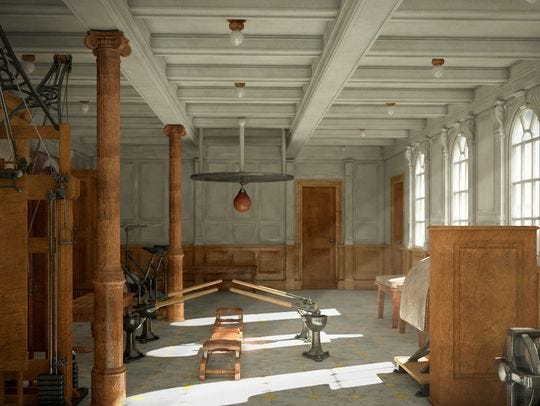Australian billionaire Clive Palmer unveiled plans Tuesday for construction of Titanic II, a cruise ship designed as a "full-scale re-creation" of the Titanic, which sank in the Atlantic Ocean in April 1912.
Displaying a blueprint for the Titanic II at a press conference aboard the Intrepid Sea, Air & Space Museum, Palmer announced that the ship will be built in China and begin carrying passengers in the third quarter of 2016.
Palmer, who refused to divulge the cost of building the ship, said "the Titanic was a ship of dreams," and "the Titanic II will be the ship where dreams come true."
The Australian businessman, who owns an Australian mining company and other businesses, said he has received an overwhelming response from prospective passengers who want to travel on Titanic II. He predicted that it "will be a real financial bonanza" so successful that he will "have to build Titanic III."
Some Titanic and cruise-ship experts doubt the Titanic II, which Palmer says will regularly sail across the North Atlantic, will be able to attract enough passengers after its maiden voyage. Some also question whether the new cruise ship desecrates the memory of those who died on the Titanic.

A computer rendering of the planned Titanic replica.
The Titanic II will be built 883 feet long – 3 inches longer than the original Titanic- and weigh 55,800 gross tons, according to Palmer. It will carry a maximum of 2,435 passengers and 900 crew members, and include a gymnasium, Turkish baths, a squash court, a swimming pool, a theater and a casino.
Its first voyage is scheduled to be from Shanghai to Southampton, England, and then on to New York.
The Titanic – the largest and most luxurious cruise ship of its time – departed from Southampton on its maiden voyage to New York in 1912 and made two stops in Europe before striking an iceberg several hundred miles off the coast of Newfoundland, Canada. More than 1,500 people aboard died after the collision.
The Titanic II, which will be built by a state-owned Chinese company, CSC Jinling Shipyard, will honor the memories of those who died and survived on the Titanic, Palmer said. The Titanic was operated by the White Star Line, and Palmer's cruise company is called Blue Star Line.
Like the original ship, there will no TVs aboard and probably no Internet service, he says.

A computer rendering of the grand staircase on the Titanic replica.
The press conference was held on an aircraft carrier in the Hudson River near where the Titanic was expected to dock in 1912 and next to another ill-fated form of transport, the supersonic Concorde.
Timing of the announcement for the unveiling of Titanic II wasn't smooth.
Palmer originally scheduled the unveiling of his plans at six kick-off events in December, but they were postponed because of the "devastation caused in New York and along the East Coast by Hurricane Sandy," which struck last October.
This month, the cruise ship industry received a black eye after a fire broke out on the Carnival Triumph, knocking out power and causing five days of hardship for 4,200 passengers until the ship was towed to shore.
Michael Driscoll, the editor of the industry newsletter Cruise Week, is skeptical about the future of Titanic II in the aftermath of the Carnival Triumph fire and last year's shipwreck of the Costa Concordia off the coast of Tuscany. The Costa Concordia slammed into a jagged reef and capsized, and 32 people were killed.
"Given all the safety concerns the industry has faced over the past 14 months – especially with Costa Concordia – such a ship would appear to have very limited appeal in this era," Driscoll says. "Themed cruises in general and even one-off re-creations of Titanic sailings in particular have proven popular in this business, but those thrive because they are done infrequently, not on a year-round basis."
Driscoll says he's been told by travel agents that Titanic II will have "very limited viability with the North American market."
Bad weather and big waves pose problems for trans-Atlantic sailings in winter, and the Titanic II "would appear to have no appeal" in regions with warmer weather, he says.

A computer rendering of the Turkish baths on the Titanic replica.
"Titanic II is a curiosity and may have a draw as a floating hotel, but the idea of spending close to a week at sea on a vessel built around such a thin premise is seen as a stretch, at least by many within the industry," Driscoll says.
Titanic expert J. Joseph Edgette, professor emeritus of education at Widener University in Chester, Pa., questions whether cruise ship passengers will continue to book Titanic II "once the initial hype is over."
He says the Titanic's primary purposes were to carry mail and cargo across the Atlantic, and it was a means of transportation for European and American passengers. In contrast, Titanic II will solely be a cruise ship, he says.
Edgette, who is also folklorist emeritus at Widener, says a cruise ship named Titanic II is "a little tacky," and there is a maritime tradition of not naming a ship after one lost at sea.
Some people may not want to travel on it because of the tragedy suffered by its predecessor or a belief it would be disrespectful to those who died on the original ship, Edgette says.
Brad Matsen, author of Titanic's Last Secrets, says "some people" like Palmer "have too much money."
There was "an immense amount of hubris in the construction of the Titanic," and that may be the case in the building of Titanic II, he says.
Matsen says the story of the Titanic still holds the "public's fascination," but he doesn't know why anyone would name a ship after it.
"There were a lot of people who died on the Titanic," Matsen says. "That's what gets lost on this."
Helen Benziger, the great-granddaughter of Molly Brown, who survived the Titanic sinking, says she is "thrilled" that the Titanic II is being built.
Benziger said at the press conference that Palmer "has assured me that everything possible has been done to honor the passengers who perished and the passengers who survived."
Paul Kurzman, whose great-grandparents, Isidor and Ida Straus, died on the Titanic, says he has "no problem" with the construction of Titanic II. Isidor served in Congress and owned R.H. Macy & Co..
He says he thinks his grandparents would also not have felt offended.
"I don't think they would have had any problem whatsoever, as long as the Titanic II steers clear of icebergs," says Kurzman, a professor of social work at Hunter College in New York.

A computer rendering of the gymnasium aboard Titanic II.
Karen Kamuda, vice president of The Titanic Historical Society in Indian Orchard, Mass., says a new cruise ship modeled after the original Titanic is a positive development.
"The Titanic was a piece of history and a symbol of an era," Kamuda says. "As we get farther away from that time, people want to feel that part of history."
Kamuda says it's not insensitive to build a ship today modeled after one involved in a tragedy.
"I'm glad people are interested in history," she says. "If a symbol like this makes people reflect on an era that's past, I don't have a problem with that."
Julie Hedgepeth Williams, whose great uncle, Albert Caldwell, survived the Titanic sinking, says she often spoke with Albert about the tragedy. She is author of A Rare Titanic Family.
She says Albert, who died in 1992, would have wanted to travel on the Titanic II.
"He would have loved to have seen it," says Williams, a professor of journalism at Samford University in Birmingham, Ala. "He would have found a new ship intriguing. He always wanted to see the Titanic again."
Source: USA Today












